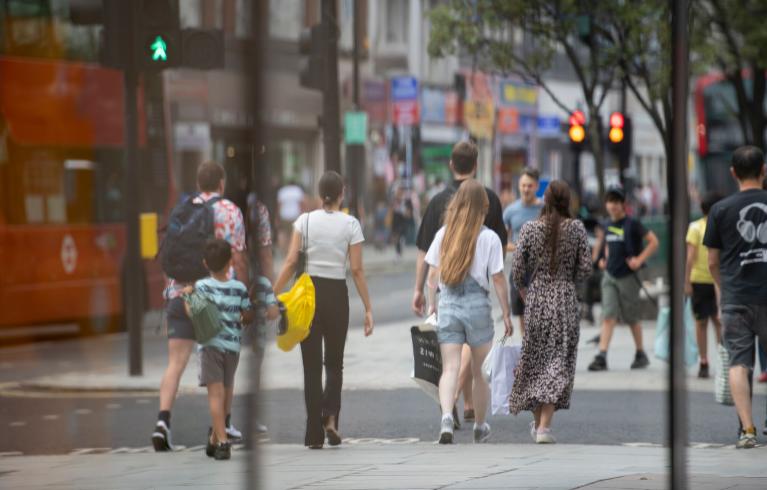
Key information
Publication type: General
Publication date:
Contents
With the 15-minute city concept becoming more prominent within the media and amongst urban planners, Chair of the London Assembly Planning and Regeneration Committee Sakina Sheikh AM discusses the impact of this concept on London and the Committee’s recent evidence gathering session in this area.
The COVID-19 pandemic brought inconceivable challenges to London. We spent weeks at a time without seeing our loved ones, with many people isolated, unable to carry out daily tasks like going to the shop for some milk and bread.
A lack of communal, open spaces within neighbourhoods in London made the lockdowns even more challenging. When your time outside is limited, how easily you can access the shops, open spaces and facilities you require becomes even more important.
The 15-minute city is an urban planning model that aims to deliver neighbourhoods with the necessities of modern life, including access to jobs, public services, recreational facilities, and other basic amenities to be available within a 15-minute walk or cycle from home.
The concept itself is not new. History has shown similar concepts come to the fore, such as the ‘garden city movement’ in the late 1800s and the ‘new town movement’ post World War II. All these concepts, whilst having different titles, in the main, seek to make amenities more accessible and beneficial to local people.
The London Assembly Planning and Regeneration Committee carried out an investigation into the 15-minute city concept in October 2023. It initially seemed confusing that the idea of having all the services you need for a thriving life within a 15-minute reach from your home had caused controversy. However, as our investigation and research began, it became clear that there were issues to consider.
The restrictions necessitated by the COVID-19 pandemic have made many of us more acutely sensitive to changes in our environment and our freedom of movement. It is likely that this is still playing out in many people’s social recovery from the pandemic, and the 15-minute city concept seems to have been caught in the middle of it.
Catherine Gall Director at Chaire Entrepreneurship Territory Innovation, who works alongside the founder of the 15-minute city concept, told the Planning and Regeneration Committee during our investigation: “If I am to leave you with one thing today, it would be to ditch the name ‘15-minute city’ and focus instead on the principles of design behind the concept.”
Catherine was right, and we can go even further by ensuring we enable people to feel like they are part of designing the way our city is being shaped for the future. This has been a key aspiration for the Planning and Regeneration Committee over the years – to find meaningful ways of engaging Londoners in planning and design that goes beyond the traditional buzz word of ‘consultation.’
As active travel becomes core to our transport strategy in London, our Committee continues to ask how planning and regeneration from City Hall can ensure that the necessary infrastructure is being built. This includes pushing for more public toilets, ensuring accessibility for those with limited mobility is a prioritised provision and continuing to enhance the outer London transport offers.
We are committed to ensuring the diverse voices and experiences in Londoners are uplifted and represented. For instance, another one of our Committee’s guests Matthew McCartney, Senior Researcher at Charter Cities Institute, pointed out, not all services need to be provided within 15 minutes from homes – the key is affordability and mobility: “A survey from 2013…showed that within a 45-minute commute by public transport Londoners can access 54 percent of the city’s jobs, which means that mobility is functioning fairly successfully in London.”
In addition to Catherine and Matthew, we were fortunate to be joined by other expert guests during our Committee’s investigation and offer our many thanks for their input and expertise: Nicholas Boys Smith, Director, Create Streets; Dr Enrica Papa, Associate Professor, Transport Planning and Management, University of Westminster, and Jonathan Lloyd, Corporate Director of Strategy and Change, Waltham Forest.
We heard from them about international comparisons, the historic evolution of the concept of 15-minute cities and related planning approaches, and how this is playing out at a London wide level. We were told that having infrastructure that is close by and accessible within 15-minutes is important but also that this wasn't something that could be achieved for everyone - which is why mobility, giving people options about how they move around towns, neighbourhoods and cities, is vital. It was also noted that many outer London areas would be less conducive to 15-minute travel, given their larger area and lower access to public transport.
The Committee believes that through improving urban planning models which consider the needs of their communities, we can improve health, wellbeing, and local economic productivity. This has the potential to bring communities closer to the amenities they need, but the messaging and narrative around the 15-minute city concept requires more work. Perhaps even a rebranding all together.
Related documents
Planning - 15 minute city opinion piece